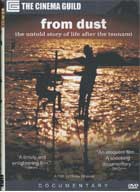
From Dust 2006
Distributed by Cinema Guild, 115 West 30th Street, Suite 800, New York, NY 10001; 212-685-6242
Produced by Dhruv Dhawan
Directed by Dhruv Dhawan
DVD, color, 56 min.
Jr. High - Adult
Social Sciences, Asian Studies
Date Entered: 03/23/2007
Reviewed by Geetha Yapa, Science Library, University of California, RiversideSri Lanka, a small island in the Indian Ocean has been relatively free from natural disasters and most citizens were not aware of the phenomenon called tsunami. That all changed on December 24th 2004 when a massive earthquake off the west coast of Northern Sumatra set off a series of tsunamis causing destruction to lives and properties in many countries in the region, including Sri Lanka. Two thirds of the densely populated coastline in Sri Lanka was affected by the tsunami, leaving thousands dead and destroying nearly one hundred thousand homes. During the aftermath of the tragedy, many people from around the world rushed to help the victims and filmmaker Dhruv Dhawan went to Sri Lanka in search of a story. He found one when he observed the suffering of people who had lost their homes and livelihoods and heard about the hardships the people had to endure in order to rebuild their homes, due to a government policy that banned reconstruction within 100 meters of the sea. This “buffer zone”, brought into effect by enforcing a pre-existing law, caused confusion among local authorities and this hampered the rebuilding process. The documentary attempts to highlight flaws and deficiencies in the system based on video footage, interviews, media clips and discussions.
The story begins with a young man from Galle, a major town on the southern coast of Sri Lanka. The camera follows him as he and other survivors get together to clear up the rubble. They find that they will have to relocate, as their original home sites were within the 100 meter buffer zone. This created a new concern about finding land. Most of the poor fishermen who were affected by the tsunami were unhappy about moving inland as it would affect their livelihoods. Bureaucratic inefficiency and slowness in responding to the crisis, scarcity of suitable land for rebuilding, increasing prices of building materials and other factors led to widespread frustration among the survivors as well as donors, who could not rebuild as quickly as intended.
Meanwhile, rumors of another tsunami created fear among people who were already traumatized by the disaster. The filmmaker implies that these rumors were spread by the government to scare people away from the costal areas so that the land could then be sold to private and foreign investors to promote tourism. This idea is supported by comments from an Australian donor and two American Marines who look at the situation from a developed country perspective that presumes that only the rich can afford to own waterfront estates. Comments from Ministry of Tourism officials are also used to support the story. What the movie fails to highlight is the fact that the Coastal Conservation Law that identifies the 100 meter buffer zone was originally intended for the purpose of preserving and managing the coast and to protect the coastal environment, and that the government’s initial reaction in enforcing the law was for public safety and environmental conservation. Government plans of making use of the coastal belt to promote tourism, which would help the country’s economy, were a subsequent development.
The film also follows the life of a disabled young fisherman as he tries to survive. The movie is interspersed with breathtaking screen shots of the Sri Lankan coast along with scenes of debris and rubble. It also includes segments that are not relevant to the overall theme of the story. Gaps due to a language barrier are evident and sometimes it is painful to watch people struggling to voice their feelings and real concerns when being questioned in a language they are not comfortable with. The documentary falls short of being authentic as it is based on the opinions from a handful of people with limited understanding of the socio-economic, political and cultural background of the country and the situation. It fails to include information from authoritative sources, while ignoring the views of different groups who were made most vulnerable by the tsunami.
Some of the details provided are misleading and facts are often misrepresented. For example, the filmmaker questions 3.5 billion dollars that were pledged. Perhaps he was unaware that all the money that was pledged was not received, that the aid was distributed among tsunami affected countries in the entire region, and that the money was intended not only for rebuilding houses, but also for restoring livelihoods, reconstruction of hospitals, schools and other infrastructure facilities. As a native of Sri Lanka who has been involved in tsunami recovery projects in locations covered in the film and who has faced similar problems in rebuilding houses for the victims, the reviewer has firsthand experience and understanding of the problems and shortcomings in the system. However, a movie with such limited focus could do more harm than good to a country ravaged by more than two decades of internal conflicts, political instability, and economic constraints.
Not recommended for libraries. Authoritative information about the tsunami recovery programs are available online at Joint evaluation of the international response to the Indian Ocean tsunami Synthesis Report, Tsunami Evaluation Coalition (TEC) - London, July 2006; and Lessons Learned from Tsunami Recovery - Key Propositions for Building Back Better, A Report by the Special Envoy for Tsunami Recovery, William J. Clinton.